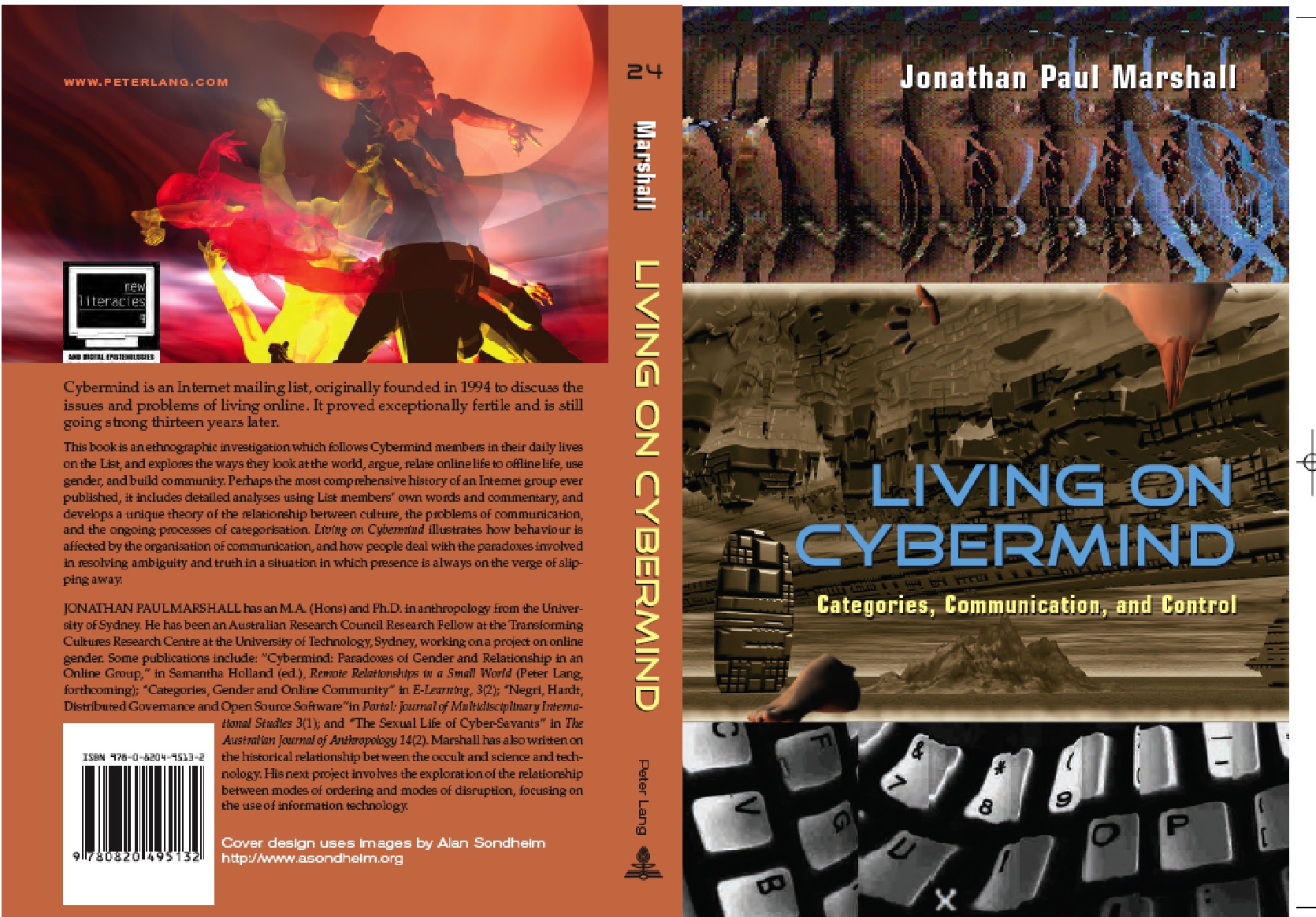Living on Cybermind:
Categories, Communication and Control
A Study of the Internet Mailing List Cybermind


[thanks to Alan Sondheim for the great cover images]
This is now published by Peter Lang
as Volume 24 in the series "New Literacies and Digital Epistemologies" edited by
Colin Lankshear, Michele Knobel, Chris Bigum, and Michael Peters.
The Publication date was early September 2007.
ISBN 978-0-8204-9513-2 (paperback) US$33.95
ISBN 978-0-8204-9514-9 (hardcover) US$100.00
Living on Cybermind: Categories, Communication and Control is an ethnographic investigation of the internet mailing list Cybermind which was founded in 1994 to discuss 'philosophical and psychological implications of subjectivity and cyberspace', and is still active thirteen years later. The book follows members of Cybermind through their daily lives on the List, exploring the ways they look at the world, relate online life to offline life, engage in dispute, build relationships, refer to the body and gender, and construct themselves as having 'community'. It is one of the most comprehensive histories and accounts of an internet group ever published and develops a new theory of the relationship between culture, communication and ongoing disputes involving categorisation. Living on Cybermind also shows how online behaviour is shaped by the organisation of communication, and explores how people deal with the paradoxes in resolving ambiguity and detecting 'authenticity' in a situation in which presence is always on the verge of slipping away.
Jonathan Marshall has recently been awarded an ARC QE II Fellowship to begin a project entitled 'Chaos and Information Technology' based at the Transforming Cultures Research Centre, in the University of Technology Sydney.
The book is being launched on Friday 14th March at Gleebooks, in Glebe Point Rd, Gleb, Sydney Australia with Angela Thomas's book Youth Online. For Further details click this link
Table of Contents from the book.
A short set of abstracts of the chapters
Professor Fredrik Barth author of the anthropological classics Political Leadership amongst the Swat Pathans, Ritual and Knowledge Among the Baktaman of New Guinea and Cosmologies in the Making wrote of the same thesis that it was "a valuable and imaginative study, combining substantive original data with highly original theoretical contributions... The ethnographic description of the Internet Mailing List 'community' is rich and detailed and to my knowledge unique". He went on to "strongly recommend" publication.
From Angela Thomas, whose book Youth Online is a detailed exploration of, mainly female, teen life online. It is well worth getting. (As already stated, we are doing a joint book launch)
From Jerry Everard author of an extremely interesting book Virtual States
Linda Leung U: Magazine March 08: p.17
In a discipline as contemporary as internet studies, there is an inevitable preoccupation with the new: the latest technologies, how they are being appropriated and by whom. Therefore it is refreshing to see Jon Marshall’s in-depth longitudinal study of a comparatively older technology – the email list. Although not as ‘sexy’ as SecondLife or YouTube, the Cybermind mailing list and its participants offer more to those readers interested in how a technology is used over time. Over its thirteen-year history (1994 to the present), Marshall has produced a compelling study, beginning with the controversial inception of the list. Playing out like a soap opera, this is more like Dynasty online, with various list owners as the main characters, conflict over how the new list should be managed, breakaway rebel groups, fear of sabotage, and a cast of middle class Netizens fractured by political differences. Marshall narrates the list happenings (netsex, flame wars even death) against a backdrop of global, historical and political events of the time.
Reference & Research Book News, Nov, 2007
This ethnographic investigation analyzes the effects of an Internet mailing list in operation since 1994 that is dedicated to the challenges and problems of living online. Marshall (online gender, Transforming Cultures Research Centre, U. of Technology, Sydney) provides analysis of members, their relationships with each other and their relations to their online universe, and the relationship between culture and communication and the ongoing process of categorization. He shows how people deal with the boundaries and ambiguities imposed by online communication, such as the untruth that one is perfectly free online and that everyone online is telling the truth. This could well serve as a model for studies of how other long-term online "cultures" formed and developed and what uses the members make of them.
From Amazon the first bad review, but it seems to be bad because the book was not what the reviewer wanted....
History of On Line Community, January 22, 2008
By J. Aragon "Feminist Educator"
I found this book in the library and thought it might be helpful for some research I'm conducting. The book wasn't what I hoped for. But, given that, it might deserve four stars for what it did do.
The author gives a painfully detailed description of Cybermind-an online community. The book details the political rants, sexist rants, and community building antics of Cybermind. The reader gets a behind the scenes examination into this online community and the resultant relationships that are established between the members. Excerpts of conversations (petty, boring, and sometimes interesting) are quoted.
This book's audience is a lay audience of people who are interested in online communities, friendships, communication, and the like. I didn't find any sections useful for my undergrads, but maybe a communications professor would?
The following Appendix was my attempt to situate Cybermind within the political and social fields of the contemporary Western English Speaking World. It is as long as a small book itself, and had to be deleted from the publication
Appendix II rtf The Modern World in Detail
I'm optimistically hoping that criticisms of the book from Cybermind members will also appear here.